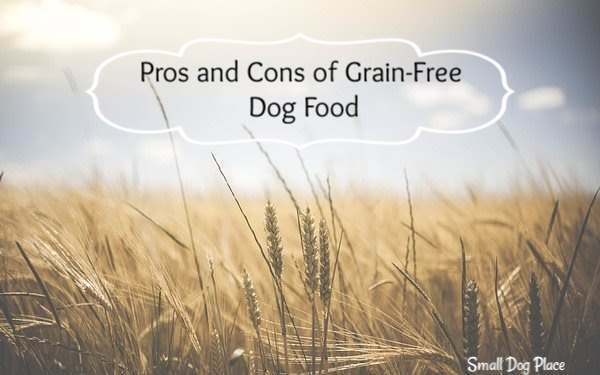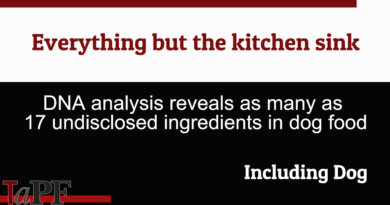Pros and Cons of Grain Free Dog Food
By Janice A. Jones | Last updated 05-04-2020
Should Your
dog be eating a Grain Free Dog Food? Or, Should you change your dog food to one with Grains?
There is
much debate about grain free dog foods from owners who love these foods to
those that suggest that all grains are fine and should be a natural part of a healthy
dog diet, period, end of debate. While both sides are digging in with their respective opinions, a new development has spread like wildfire over the internet.
The debate has gotten even worse after the FDA issued a warning to dog parents and veterinarians that they had found a link between dogs who ate foods high in peas, lentils, potatoes, and other grain legumes and canine dilated cardiomyopathy (DCM). These ingredients are typically found in grain free dog foods.

It is no wonder that the average pet owner is confused. Consider the arguments in favor of a grain free dog food.
On the one
hand, those that prefer grain-free, suggest that grain free
formulas are more natural, and more like the
ancestral diet of dogs. They make the
point that dogs are carnivores and any plant-based portion of the diet should be
limited. This has since been debunked by science. As it turns out, dogs have developed the ability to digest grains overtime. 1
Some pet owners, according to Lorie Huston, DVM, want a dog food that imitates their own human diet. In recent years people have chosen a grain free or gluten free diet for themselves and the pet food manufacturers have created these formulas for dogs because they know that people will find them attractive and purchase them.
A third group advocate for grain free because they assume that grains are the culprit of common canine allergies. This thinking as also proven to be incorrect based on the scientific literature. In one review of the literature, it was found that the two most common ingredients that cause food allergies in dogs was beef and dairy. 2
It is true that dogs can have allergies to certain foods and often these allergies are manifested with skin irritations such as itchiness, hot spots, and skin irritations.
Grains Used as Protein Sources
The most common grains used in dog foods are corn, wheat, soy, and white
rice. They are cheap and they can
provide an extra amount of plant-based protein.
Protein is very important in the canine diet. This is important for dog food manufacturers to show on the label that
they have adequate protein. What does all of this mean to you?
Look at a dog food label with a high protein percentage? Looks great, doesn’t it? But look a little closer and you’ll find that the food high in protein actually contains plant based protein such as found in corn and wheat, with little in the way of actual animal protein such as chicken, beef, or fish, the type of protein needed most by dogs.
High Glycemic Foods
Many of these cheap grains that fill up our dog’s diet are also high on the Glycemic Index (GI), an index
that rates ingredients by how quickly and how high they can cause blood sugar
levels to rise. High GI carbohydrates
can produce a chronic inflammatory response in the body which can lead to
obesity, diabetes, heart disease, arthritis, and cancer.
Some foods have been found to cause some intolerance or sensitivities (not
allergies). Food tolerances or
sensitivities tend to build up over time leading to problems that are often misdiagnosed
such as GI problems and skin allergies, which may end up being the fault of the food your dog eats.
You end up feeding more of these grain filed foods because they do give
the dog a quick burst of energy but it does not last throughout the day, which
means your dog is hungry and ready to eat again.
This can lead to obesity.
Grain-free dog foods often have
more concentrated energy sources. They contain a higher standard of protein and
fat that comes from animal sources.
These types of foods can meet the dog’s needs in smaller quantities, so
you tend to use less food.
Grains, like corn or wheat, can activate
food sensitivities in some dogs. Choosing a grain-free dog food prevents this
from happening.
Why Not Serve Wheat to Your Dog?
Wheat is a low-cost
source of protein, as opposed to say Bison or Salmon. Gluten is the sticky protein found in wheat
and it has been known to create havoc in people especially sensitive to it.
Celiac disease in humans, (sensitivity to
gluten) causes gas, bloating, and diarrhea and can lead to a low-grade autoimmunity that can cause inflammation
throughout the body. Experts are seeing the same effect in some dogs.
Why Not Soy?
Soy in moderation is not a bad thing. Soy is used in dog food as a source of protein bumping up the protein percentage.
There are good reasons why soy should not be a part of your dog’s food. Much of the issues revolve around the manufacturing process and the part of the soybean used. Rodney Habib from Dog Naturally reported that 90% of the soy crop in the U.S. is genetically modified. The soybeans are mashed into oil and fats and the meal is separated out. Human grade foods use the fats and oil and the meal is used in non-human foods such as dog food. Furthermore, Rodney goes on to say
- “High levels of the pesticide, RoundUp were found in GMO soybeans”
- “The soybean contains large quantities of natural toxins or ‘antinutrients.’ which can cause problems in many organ systems of the body”
- “Soy interferes with the thyroid gland’s ability to make T4 (thyroxine) and (T3) tri-iodothyronine, hormones necessary for normal thyroid function.”
Any one of these issues would scare me, how about you?
Corn?
Corn is not a bad ingredient per se. In fact, it can be beneficial. It provides protein, a necessary ingredient in the canine diet. It also serves as an easily digestible carbohydrate which is a key energy source. It also contains linoleic acid, an omega 6 fatty acid, which is necessary for healthy skin, coat and immune system. Corn also contains vitamin E and beta-carotene which also supports a healthy immune system.
So, why the fuss about corn?
Beyond what
was written above about soy and wheat, corn can contain contaminants
that can put dogs at risk.
The corn we eat that is fresh, canned or
frozen, is not the same corn that goes into dog food.
Rather, the
cheapest feed grade corn is used
in dog foods, the same feed that is used for livestock. The corn could be
contaminated with mycotoxins.
Dog foods with corn as the first ingredient may be high in protein but that protein is plant based, not a healthy animal based protein. Animal based protein is far superior to plant based in the canine diet.
So, is Grain Free Dog Food Better for Your Dog?
There are
some real benefits to a grain free dog food.
In the wild,
dogs were scavengers, finding carcasses
that contained meat and stomach contents.
They devoured it all getting the meat protein and plant material that may have been in the stomach of the dead animal. In this way, a grain free diet is closer to
the dog’s ancestors diet.
However, it should be noted that dogs no more
eat the kinds of food their ancestors did 15,000 years ago then people eat the caveman’s diet. For that
matter, people eat very differently today than their grand or great grandparents
did 50 or 75 years ago.
Grain Free Dog Food
Benefits
- The dog eats less of the food for the same amount of nutrients, which may be a good choice for overweight dogs.
- With the dog eating less, the cost to feed may be less.
- The food could be safer without contaminants and ingredients that could lead to allergies.
- Without the grains, the food may contain healthy vegetables and fruits to make up the carbohydrate percentage.
Grain Free Dog Food
Problems
- Grain free dog foods are generally more expensive than those with grains.
- Potential for Canine Dilated Cardiomyopathy (see below)
- Grain free is not likely to be healthier if it uses anything other than named animal sources, (i.e. chicken, chicken meal, as opposed to poultry, poultry meal)
Grain Free Dog Food and Dilated Cardiomyopathy
Usually, if the
food is grain free, the absences of the grains mean
that other foods are substituted which may be healthier to the dog such as
vegetables and fruits. But as the study done by the FDA suggests, substitutes often include peas, potatoes, lentils and grain legumes which correlates with higher incidence of canine dilated cardiomyopathy (CDM).
According to Linda Case MS, Canine Dilated Cardiomyopathy is a disorder “characterized by weakening of the heart muscle, which leads to a decreased ability of the heart to pmp and if untreated, to cardiac failure.”
What is often unwritten about this problem on well-meaning websites is the fact that the study found a significant number of dogs with the DCM also had lower levels of circulating taurine, an amino acid.
Statistically speaking there was a correlation between dogs with DCM, a lower level or taurine and the consumption of a grain free dog food. This does not mean one caused the other. Put simply, there is a connection, but one does not cause the other.
Taurine is routinely provided in cat food because it is considered an essential amino acid, meaning that cats cannot synthesize their own. Dogs, on the other hand were thought to be capable of making this amino acid on their own from two other amino acids, methionine and cysteine.
It turns out that some breeds are prone to taurine deficiency due to their inability to make taurine or the loss of it in the feces. Large dog breeds seem to be more at risk than small dogs.
The list of ingredients often found in grain free dog food are substitutes for the typical grains added to foods that contain grains. This is a common practice in a wide range of dog foods that are grain free. At the time of this writing, no conclusions have been made and more research is needed.
Grain Free Dog Food Recommendations
If your dog is doing well on a grain free dog food, but you are worried about the possibility of CDM, our best recommendation is to talk to your veterinarian.
How to Choose a Good Grain Free Dog Food
Just as much
care should go into choosing a grain free dog food as it would be for accepting any food. Not all formulas are perfect for all
dogs.
- Look at the
ingredient list, especially the first 6 or 7 ingredients. You should see at least one if not more
protein sources that come from animals or fish. - Look at
whether the food is appropriate for your dog’s age and size. (Puppy, All-Life Stages, Adult, Large Breed, Small Breed) - Pick one that
substitutes grains for fruits and vegetables. If your small dog is a picky eater,
you might find that grain free diets are much more palatable. - Choose one
that uses food sources that are farmed, caught, or raised on ranches nearby such as in Canada or the U.S.A. - Look at the
company’s track record for food
recalls. - Look to see
if the company manufactures their own food
The Bottom
Line
All grains
are not bad but many dogs are sensitive to them and can benefit from being fed
a product that does not contain grains as the source of carbohydrates and protein. This is especially true if your dog is
experiencing any problems
- Skin
irritations, excessive scratching, biting or licking on self - GI
disturbances such as gas, bloat, vomiting or diarrhea - Ear
infections
It is
worthwhile looking into a grain free diet. Please not however, that if a food allergy exists, it could be due to something other than grains.
Remember, A grain free dog food does not mean that the dog is eating a carbohydrate free diet. That would be equally
unhealthy. Dogs like people need
a decent amount of carbohydrates for energy and fiber in their diets to maintain digestive health.
Check with your dog’s veterinarian before making any decisions about dog food.
References
1. Axelsson, Erik et al. The genomic signature of dog domestication reveals adaptation to a starch-rich diet. Nature. 2013; 495: 360–364
2. Carlotti DN, Remy I, Prost C. Food allergy in dogs and cats. A review and report of 43 cases. Vet Dermatol 1990;1:55-62.
An excellent overview of the problems you might encounter with a grain free dog food along with a comprehensive section on cardiomyopathy can be found at the Doggypedia, Should You Feed Your Dog Grain Free Dog Food?
This article is accurate and true to the best of the author’s knowledge. No advice on this website is meant to substitute for a diagnosis, treatment or advice from a veterinarian. Dogs showing symptoms of distress or illness should be seen by a veterinarian immediately.
Want to Learn More About Dog Nutrition?
There are quite a few resources on the internet but I’d like to introduce you to a couple of books that I have read and found very helpful.
Canine Nutrigenomics by W. Jean Dodds and Diana R. Laverdure takes an entirely new look at the science of canine nutrition.
Don’t let the name of the book scare you, as the authors break down the subject matter in easy to understand chunks of knowledge.
This is a very useful guide if your dog is also suffering from a life threatening condition that can be helped through the food he eats.
For someone serious about learning more about canine nutrition, this is the best resource I’ve found so far. It is a textbook used in the veterinary field, so it is written in a more scholarly tone. I’ve used this book countless times when writing many of the nutrition articles on this site. Written by Linda P. Case, Leighann Daristotle, Michael G. Hayek, and Melody Foess Raasch
Does This Article Deserve Your Thumbs Up?
We always appreciate your support and encouragement. Your thumbs up means so much to us.

Free Monthly Newsletter
Sign Up for Our Free Newsletter and get our Free Gift to You.
my E-book, The Top 10 Mistakes People Make When Choosing a Dog (and how to avoid them)
If you enjoyed this page, I’d love it if you’d let me know. Just click the button below. Thank you.
Sharing is Caring







It’s too bad to check your article late. I wonder what it would be if we met a little faster. I want to exchange a little more, but please visit my site casino online and leave a message!!
[url=http://zestoretica.online/]zestoretic price[/url]